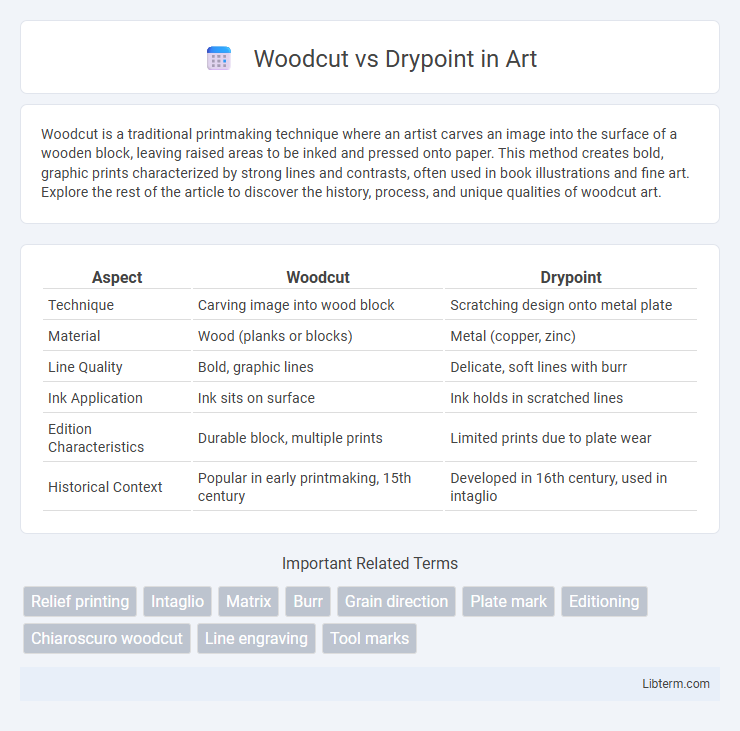Woodcut is a traditional printmaking technique where an artist carves an image into the surface of a wooden block, leaving raised areas to be inked and pressed onto paper. This method creates bold, graphic prints characterized by strong lines and contrasts, often used in book illustrations and fine art. Explore the rest of the article to discover the history, process, and unique qualities of woodcut art.
Table of Comparison
| Aspect | Woodcut | Drypoint |
|---|---|---|
| Technique | Carving image into wood block | Scratching design onto metal plate |
| Material | Wood (planks or blocks) | Metal (copper, zinc) |
| Line Quality | Bold, graphic lines | Delicate, soft lines with burr |
| Ink Application | Ink sits on surface | Ink holds in scratched lines |
| Edition Characteristics | Durable block, multiple prints | Limited prints due to plate wear |
| Historical Context | Popular in early printmaking, 15th century | Developed in 16th century, used in intaglio |
Introduction to Printmaking Techniques
Woodcut and drypoint represent two distinct printmaking techniques that each create unique textural effects through different processes. Woodcut involves carving an image into a wooden block, where the raised areas are inked and pressed onto paper, producing bold, high-contrast prints. Drypoint utilizes a sharp needle to incise lines directly onto a metal plate, generating delicate, velvety lines due to the burr created on the surface, resulting in a more intimate and detailed aesthetic.
What is Woodcut?
Woodcut is a traditional relief printing technique where an image is carved into the surface of a wooden block, leaving the raised areas to receive ink and transfer the design onto paper. This method allows for bold, high-contrast prints with distinct textures created by the wood grain. Woodcut is favored for its durability and ability to produce multiple consistent impressions.
What is Drypoint?
Drypoint is an intaglio printmaking technique where an image is incised directly onto a metal plate using a sharp needle. Unlike woodcut, which involves carving into a wood block, drypoint creates burrs that hold ink, producing rich, velvety lines with distinctive texture. The technique allows for fine detail and subtle tonal variations, making it favored for expressive and intricate designs.
Historical Background of Woodcut and Drypoint
Woodcut, originating in ancient China around the 9th century, became a dominant printmaking technique in Europe by the 15th century, particularly influencing the Renaissance art movement. Drypoint emerged in the 16th century, credited to artists like Albrecht Durer, who sought finer lines and richer textures than those achievable with woodcut. Both techniques significantly shaped the evolution of printmaking, with woodcut emphasizing bold, graphic contrasts and drypoint focusing on delicate, detailed line work.
Tools and Materials: Woodcut vs Drypoint
Woodcut uses a sharp gouge or knife to carve designs into a wooden block, typically made from hardwoods like cherry or maple, chosen for their durability and fine grain. Drypoint employs a sharp metal needle or stylus to scratch directly onto a metal plate, often copper or zinc, creating burrs that produce rich, velvety lines on the print. Both techniques require specific tools and materials that influence the texture and detail achievable in the final artwork.
Artistic Process Comparison
Woodcut involves carving an image into a wooden block, where the raised areas transfer ink onto paper, creating bold, graphic lines with high contrast. Drypoint utilizes a sharp needle to etch fine, delicate lines directly onto a metal plate, producing rich, velvety textures and soft shading through the burr created by displaced metal. The artistic process of woodcut emphasizes decisive, strong line work and contrasts, while drypoint allows for more nuanced detail and subtle tonal variations.
Visual and Textural Differences
Woodcut prints exhibit bold, high-contrast visuals with sharp, graphic lines created by carving into the wood surface, resulting in clear, defined shapes and areas of solid black and white. Drypoint prints feature softer, more delicate lines due to the burin scratching directly onto the metal plate, producing a rich, velvety texture with subtle tonal variations and an intimate, expressive quality. The tactile quality in woodcuts is more uniform and crisp, whereas drypoint reveals intricate line work with a distinctive burr edge that adds depth and complexity to the image.
Advantages and Challenges of Woodcut
Woodcut offers distinct advantages such as bold, high-contrast images and durability of the printing block, making it ideal for producing multiple prints with consistent quality. The technique allows for straightforward carving using chisels and knives, enabling artists to achieve strong graphic effects suitable for both fine art and commercial printing. Challenges of woodcut include the difficulty in rendering fine details due to the grain of the wood and the labor-intensive process of preparing and cutting the block, which can limit the complexity of designs compared to drypoint etching.
Pros and Cons of Drypoint
Drypoint offers rich, velvety lines and a distinctive textured quality due to the burr created by the needle, enhancing depth and character in prints. Its major drawback is the burr's fragility, which wears down quickly during printing, limiting the number of high-quality impressions achievable. Compared to woodcut, drypoint allows for finer detail but requires more careful handling and provides fewer durable prints.
Choosing Between Woodcut and Drypoint for Your Art
Choosing between woodcut and drypoint depends on the desired texture and detail in your artwork; woodcut offers bold, graphic lines with high contrast, while drypoint provides delicate, fine lines with rich tonal variation. Woodcut involves carving into a wooden block, ideal for strong, architectural designs, whereas drypoint uses a metal plate scratched with a sharp needle, allowing for softer, more intricate details. Consider the durability of prints and your intended edition size, as woodcuts yield longer print runs compared to the limited capacity of drypoint plates.
Woodcut Infographic

 libterm.com
libterm.com